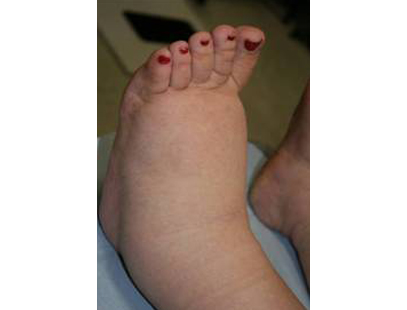
Lymphoedema Feet
What is lymphoedema?
Lymphoedema is a condition that causes swelling in the body’s tissue. It is a chronic condition which can lead to pain and loss of movement. We all have body tissues that comprise of a small amount of fluid also known as lymph. Water and sustenance are supplied to the tissues when this fluid (lymph) leaves our blood system. The lymphatic system is a structure of drainage tubes, a bit like blood vessels which collects most of this fluid. One of the roles of the lymphatic system is to drain any surplus fluid from tissues. If the lymphatic system is damaged or disrupted, it will not be able to drain any surplus fluid thus causing the tissue to swell.
This swelling from the build up of fluid (lymph) in the body due to not being drained out properly is known as lymphoedema. Lymphoedema generally affects the arms or legs, even though in some cases there may be swelling in the head or chest. To begin with, the swelling is usually visible at the end of the day and it will go down during the night. Nevertheless, if this swelling is not treated appropriately then this will cause the fluid to permanently remain in the leg.
What causes lymphoedema?
Being born without enough lymphatics is the cause which is the most common for lymphoedema. Not having enough lymphatics can interfere with the development of the lymphatic system, causing it to not drain fluid properly. Lymphoedema can develop at birth or around puberty when there are only a small amount of lymphatics in the body. This kind of lymphoedema is known as Milroy’s disease. Usually one leg is found to be worse than the other and at times one leg is the only one that is affected. In cases that are less severe, the lymphatics might be able to manage to begin with and then stop working as you age. This type of lymphoedema is known as lymphoedema tarda.
Are there any other causes?
Lymphoedema can be caused when the lymphatic system has become damaged by an injury, infection, cancer or trauma. The lymphatics of the arm and leg may have become damaged by surgery or lymphoedema may be developed as a side effect from treating cancer. Sometimes it is essential to eliminate lymph glands to stop the cancer from spreading, damage to the lymphatic system can occur but this is inevitable at times. The same goes for radiotherapy, where high energy radiation is used to wipe out cancer cells; this can also harm the lymphatic system.
What are the symptoms of lymphoedema?
The main symptom of lymphoedema is swelling and pain in the arms or legs. This can be troublesome when it comes to fitting into clothes or footwear or wearing things like watches, bracelets etc. Some other symptoms comprise of losing some movement in the affected limb, the limb experiencing pain, having painful joints from swelling in the knee or elbow or frequent skin infections. If lymphoedema is not managed properly then there is a higher risk of infection under the skin known as cellulitis. Recurring cellulitis can cause more damage to the lymphatic system. If this continues to go on then it could lead to even worse infections, even ulcers and in worse cases, amputation of a limb.
What is the treatment for lymphoedema?
Lymphoedema is not curable but it can be managed to stop other problems from arising at a later date. Lymphoedema can be treated by using special compression stockings and bandages that are used to move fluid out of the limb that is affected. Elevating the limb and external pneumatic compression are also used.
Elevation of the limb
Elevating the leg will help the fluid to drain out of it. Putting your legs up as much as possible and as high as you can manage will all help in relieving the symptoms. Having the end of your bed elevated by around six inches so that your feet are a bit higher than your head will help reduce the swelling and help with drainage of the excess fluid.
Compression bandages or stockings
When you are standing up, compression is necessary to squeeze the fluid out of your legs. You may have to use bandages to eliminate the worse of the swellings first then use compression stockings. These stockings are a lot stronger than regular support tights; this is why they will need to be made especially for you to have the proper fitting. If only the lower leg is affected by swelling then a stocking below the knee can be worn. The customary strength of a stocking is class 2, but at times a class 3 may be needed. Also you can purchase a stocking applicator if you find it hard to put on your stockings.
External Pneumatic Compression (EPC)
In spite of using compression stockings, numerous people still have swelling that builds up by the evening. The external pneumatic compression tool is a pneumatic boot. This boot inflates and deflates; by doing this it squeezes the fluid out of the leg. The EPC device is usually used at the end of the day to clear any built up fluid regardless of using compression stockings. If EPC therapy is needed then your doctor may be able to help try out this device before you decide to purchase it.
What about surgery?
Lymphoedema to date has not been cured by any operation. If your leg continues to stay swollen after trying the compression therapy then surgery may be recommended to reduce the size of the lower leg, this is known as Homan’s reduction.
How can I help myself?
You can help yourself by taking part in an ample amount of exercise and not being overweight. Elevate your legs when you can throughout the day and during the night. Ensure you wear compressions stockings every day from the morning to night time.

















